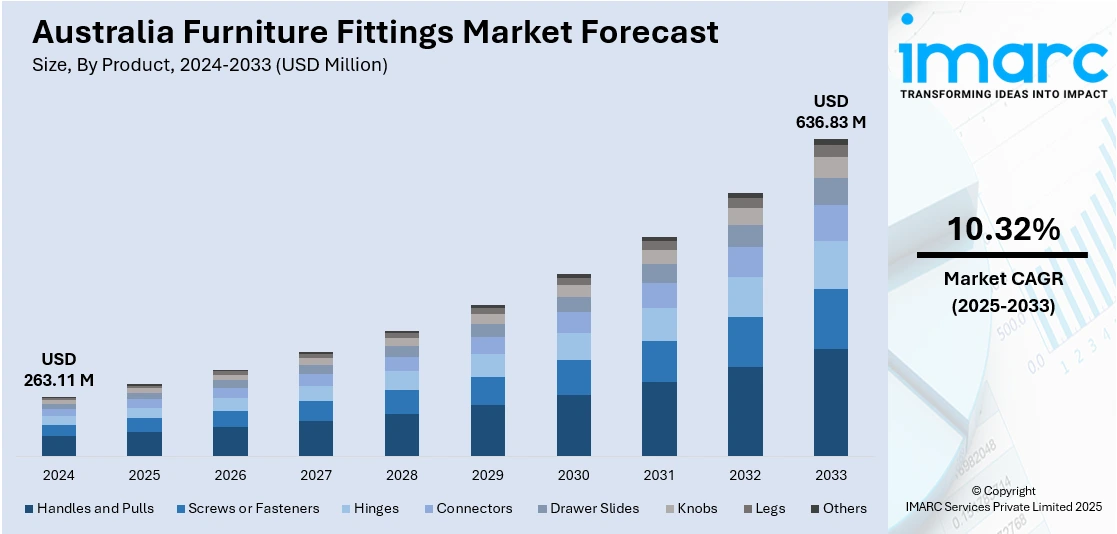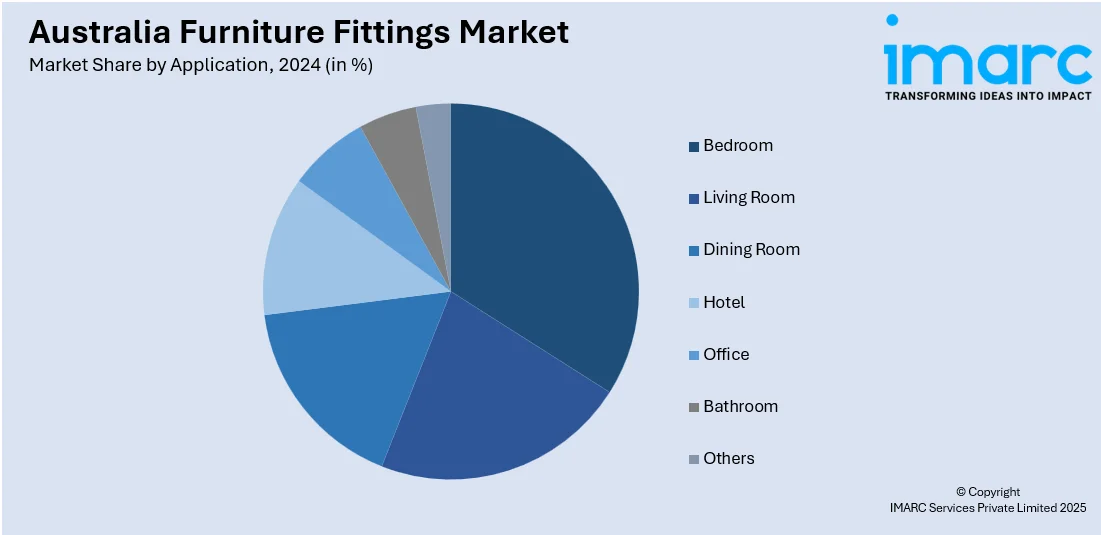
Australia Furniture Fittings Market Size, Share, Trends and Forecast by Product, Material, Application, Distribution Channel, End User, and Region, 2025-2033
Australia Furniture Fittings Market Overview:
The Australia furniture fittings market size reached USD 263.11 Million in 2024. Looking forward, IMARC Group expects the market to reach USD 636.83 Million by 2033, exhibiting a growth rate (CAGR) of 10.32% during 2025-2033. The market involves the rising consumer demand for sustainable and eco-friendly products, fueled by growing environmental awareness. Technological advancements also play a crucial role, with smart fittings enhancing functionality and convenience in modern homes. Additionally, increasing urbanization and smaller living spaces push demand for customizable and space-saving fittings. Changing lifestyle preferences and the desire for personalized designs further encourage innovation among manufacturers, making the market more dynamic and consumer-focused further impelling the Australia furniture fittings market share.
|
Report Attribute
|
Key Statistics
|
|---|---|
|
Base Year
|
2024
|
|
Forecast Years
|
2025-2033
|
|
Historical Years
|
2019-2024
|
| Market Size in 2024 | USD 263.11 Million |
| Market Forecast in 2033 | USD 636.83 Million |
| Market Growth Rate 2025-2033 | 10.32% |
Australia Furniture Fittings Market Trends:
Customization and Personalization
Personalization is driving the Australia’s furniture fittings market growth, as consumers increasingly demand solutions tailored to their unique style, space, and functional requirements. Whether it’s a choice of finishes, handle styles, or modular components, customization allows people to create furniture that feels uniquely theirs. This trend is particularly strong in urban areas where space optimization is critical, driving demand for adaptable solutions like extendable drawers or interchangeable components. Manufacturers are responding with design flexibility, offering bespoke options without compromising on quality or lead times. Digital design tools and three dimensional (3D) visualization have also made it easier for consumers to be part of the design process. This hands-on approach appeals to those wanting more than mass-produced furniture, favoring pieces that fit seamlessly into their lifestyle and décor. Personalization isn’t just a luxury it’s becoming an expectation in modern furniture design.

To get more information on this market, Request Sample
Sustainability and Eco-Friendly Materials
Sustainability has become a core focus in Australia’s furniture fittings market, driven by growing consumer demand for eco-friendly products made from sustainably sourced wood, recyclable metals, and non-toxic finishes. Manufacturers are prioritizing ethical sourcing and energy-efficient production to meet these expectations. Reflecting a deeper shift towards conscious living, design trends emphasize durability and longevity, encouraging quality over quantity. Retailers promote green certifications and modular, repairable fittings to reduce waste. The Environmentally Sustainable Procurement (ESP) Policy was put into effect by the Department of Climate Change, Energy, the Environment, and Water (DCCEEW) in November 2024 in accordance with this movement. All government procurement of furnishings and fittings costing more than $1 million must adhere to stringent sustainability standards starting in July 2025. This policy supports the market’s eco-conscious transformation, pushing brands to innovate and ensuring furniture fittings uphold environmental stewardship and long-term usability.
Integration of Smart Technologies
The fusion of furniture fittings with smart technologies is transforming how Australians interact with their living spaces. From sensor-activated lighting to automated sliding systems, modern fittings now offer more than just structural support—they enhance user experience. Smart homes are becoming more common, and fittings are evolving to sync with this lifestyle. For instance, integrated universal serial bus (USB) charging ports in drawers or voice-controlled cabinet lighting are increasingly sought after. These innovations not only add convenience but also elevate the overall aesthetic and functionality of furniture. Manufacturers are embracing this trend by incorporating electronics seamlessly into their designs, making smart features intuitive and user-friendly. This shift reflects a broader desire for homes that adapt to the user, promoting efficiency and comfort. As technology continues to evolve, fittings are no longer static fixtures but dynamic components of a responsive, connected environment.
Australia Furniture Fittings Market Segmentation:
IMARC Group provides an analysis of the key trends in each segment of the market, along with forecasts at the country and regional levels for 2025-2033. Our report has categorized the market based on product, material, application, distribution channel, and end user.
Product Insights:
- Handles and Pulls
- Screws or Fasteners
- Hinges
- Connectors
- Drawer Slides
- Knobs
- Legs
- Others
The report has provided a detailed breakup and analysis of the market based on the product. This includes handles and pulls, screws or fasteners, hinges, connectors, drawer slides, knobs, legs, and others.
Material Insights:
- Stainless Steel
- Aluminium Alloy
- Zinc Alloy
- Plastic
- Iron
- Others
A detailed breakup and analysis of the market based on the material have also been provided in the report. This includes stainless steel, aluminium alloy, zinc alloy, plastic, iron, and others.
Application Insights:

- Bedroom
- Living Room
- Dining Room
- Hotel
- Office
- Bathroom
- Others
The report has provided a detailed breakup and analysis of the market based on the application. This includes bedroom, living room, dining room, hotel, office, bathroom, and others.
Distribution Channel Insights:
- Direct
- In-Direct
A detailed breakup and analysis of the market based on the distribution channel have also been provided in the report. This includes direct, and in-direct.
End User Insights:
- Residential/ Household
- Commercial
The report has provided a detailed breakup and analysis of the market based on the end user. This includes residential/ household, and commercial.
Regional Insights:
- Australia Capital Territory & New South Wales
- Victoria & Tasmania
- Queensland
- Northern Territory & Southern Australia
- Western Australia
The report has also provided a comprehensive analysis of all the major regional markets, which include Australia Capital Territory & New South Wales, Victoria & Tasmania, Queensland, Northern Territory & Southern Australia, and Western Australia.
Competitive Landscape:
The market research report has also provided a comprehensive analysis of the competitive landscape. Competitive analysis such as market structure, key player positioning, top winning strategies, competitive dashboard, and company evaluation quadrant has been covered in the report. Also, detailed profiles of all major companies have been provided.
Australia Furniture Fittings Market News:
- In April 2025, Danny’s Desks & Chairs supports Australia’s growing startup scene with affordable, scalable office furniture designed for small spaces. Offering versatile L-shaped desks, ergonomic chairs, and mobile storage, they help startups create efficient, professional workspaces. Their online catalogue and personalized service assist businesses in choosing stylish, budget-friendly setups that can grow with them. With fast delivery across Australia, Danny’s is a trusted partner for startups seeking practical, future-ready office solutions.
- In December 2024, Country Road and Melbourne-based Tait have launched the limited-edition ‘Saltbush’ outdoor furniture range, available from December 3, 2024. This collaboration blends Tait’s durable, handcrafted designs—rooted in Australian craftsmanship with Country Road’s 1970s-inspired aesthetic. The collection pays homage to the Australian outdoor lifestyle and Saltbush plant. Tait’s solar-powered factory employs 25 skilled artisans, combining traditional techniques with modern automation to create high-quality, locally made furniture.
Australia Furniture Fittings Market Report Coverage:
| Report Features | Details |
|---|---|
| Base Year of the Analysis | 2024 |
| Historical Period | 2019-2024 |
| Forecast Period | 2025-2033 |
| Units | Million USD |
| Scope of the Report |
Exploration of Historical Trends and Market Outlook, Industry Catalysts and Challenges, Segment-Wise Historical and Future Market Assessment:
|
| Products Covered | Handles and Pulls, Screws or Fasteners, Hinges, Connectors, Drawer Slides, Knobs, Legs, Others |
| Materials Covered | Stainless Steel, Aluminium Alloy, Zinc Alloy, Plastic, Iron, Others |
| Applications Covered | Bedroom, Living Room, Dining Room, Hotel, Office, Bathroom, Others |
| Distribution Channels Covered | Direct, In-Direct |
| End Users Covered | Residential/ Household, Commercial |
| Regions Covered | Australia Capital Territory & New South Wales, Victoria & Tasmania, Queensland, Northern Territory & Southern Australia, Western Australia |
| Customization Scope | 10% Free Customization |
| Post-Sale Analyst Support | 10-12 Weeks |
| Delivery Format | PDF and Excel through Email (We can also provide the editable version of the report in PPT/Word format on special request) |
Key Questions Answered in This Report:
- How has the Australia furniture fittings market performed so far and how will it perform in the coming years?
- What is the breakup of the Australia furniture fittings market on the basis of product?
- What is the breakup of the Australia furniture fittings market on the basis of material?
- What is the breakup of the Australia furniture fittings market on the basis of application?
- What is the breakup of the Australia furniture fittings market on the basis of distribution channel?
- What is the breakup of the Australia furniture fittings market on the basis of end user?
- What is the breakup of the Australia furniture fittings market on the basis of region?
- What are the various stages in the value chain of the Australia furniture fittings market?
- What are the key driving factors and challenges in the Australia furniture fittings market?
- What is the structure of the Australia furniture fittings market and who are the key players?
- What is the degree of competition in the Australia furniture fittings market?
Key Benefits for Stakeholders:
- IMARC’s industry report offers a comprehensive quantitative analysis of various market segments, historical and current market trends, market forecasts, and dynamics of the Australia furniture fittings market from 2019-2033.
- The research report provides the latest information on the market drivers, challenges, and opportunities in the Australia furniture fittings market.
- Porter's five forces analysis assist stakeholders in assessing the impact of new entrants, competitive rivalry, supplier power, buyer power, and the threat of substitution. It helps stakeholders to analyze the level of competition within the Australia furniture fittings industry and its attractiveness.
- Competitive landscape allows stakeholders to understand their competitive environment and provides an insight into the current positions of key players in the market.
Need more help?
- Speak to our experienced analysts for insights on the current market scenarios.
- Include additional segments and countries to customize the report as per your requirement.
- Gain an unparalleled competitive advantage in your domain by understanding how to utilize the report and positively impacting your operations and revenue.
- For further assistance, please connect with our analysts.
 Request Customization
Request Customization
 Speak to an Analyst
Speak to an Analyst
 Request Brochure
Request Brochure
 Inquire Before Buying
Inquire Before Buying




.webp)




.webp)












